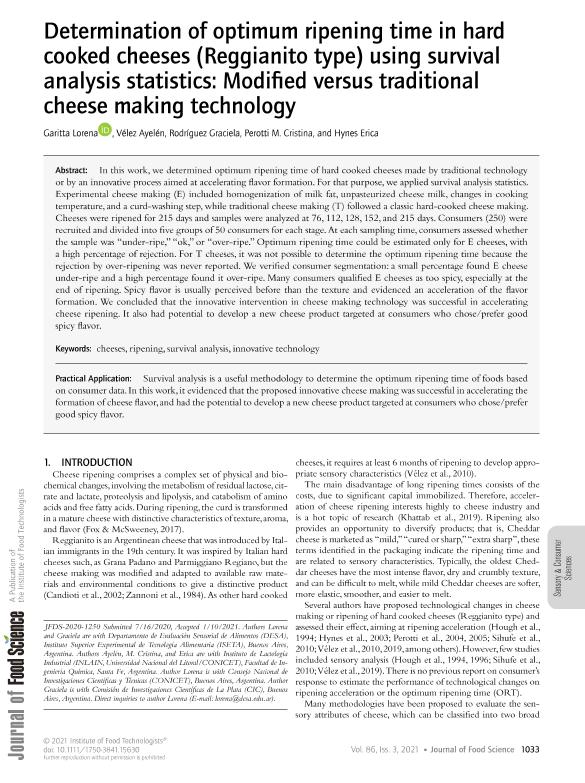Mostrar el registro sencillo del ítem
dc.contributor.author
Garitta, Lorena Garitta

dc.contributor.author
Vélez, María Ayelén

dc.contributor.author
Rodríguez, Graciela
dc.contributor.author
Perotti, Maria Cristina

dc.contributor.author
Hynes, Erica Rut

dc.date.available
2022-08-02T10:56:20Z
dc.date.issued
2021-01
dc.identifier.citation
Garitta, Lorena Garitta; Vélez, María Ayelén; Rodríguez, Graciela; Perotti, Maria Cristina; Hynes, Erica Rut; Determination of optimum ripening time in hard cooked cheeses (Reggianito type) using survival analysis statistics: Modified versus traditional cheese making technology; Wiley Blackwell Publishing, Inc; Journal of Food Science; 86; 3; 1-2021; 1033-1038
dc.identifier.issn
0022-1147
dc.identifier.uri
http://hdl.handle.net/11336/163806
dc.description.abstract
Abstract: In this work, we determined optimum ripening time of hard cooked cheeses made by traditional technology or by an innovative process aimed at accelerating flavor formation. For that purpose, we applied survival analysis statistics. Experimental cheese making (E) included homogenization of milk fat, unpasteurized cheese milk, changes in cooking temperature, and a curd-washing step, while traditional cheese making (T) followed a classic hard-cooked cheese making. Cheeses were ripened for 215 days and samples were analyzed at 76, 112, 128, 152, and 215 days. Consumers (250) were recruited and divided into five groups of 50 consumers for each stage. At each sampling time, consumers assessed whether the sample was “under-ripe,” “ok,” or “over-ripe.” Optimum ripening time could be estimated only for E cheeses, with a high percentage of rejection. For T cheeses, it was not possible to determine the optimum ripening time because the rejection by over-ripening was never reported. We verified consumer segmentation: a small percentage found E cheese under-ripe and a high percentage found it over-ripe. Many consumers qualified E cheeses as too spicy, especially at the end of ripening. Spicy flavor is usually perceived before than the texture and evidenced an acceleration of the flavor formation. We concluded that the innovative intervention in cheese making technology was successful in accelerating cheese ripening. It also had potential to develop a new cheese product targeted at consumers who chose/prefer good spicy flavor. Practical Application: Survival analysis is a useful methodology to determine the optimum ripening time of foods based on consumer data. In this work, it evidenced that the proposed innovative cheese making was successful in accelerating the formation of cheese flavor, and had the potential to develop a new cheese product targeted at consumers who chose/prefer good spicy flavor.
dc.format
application/pdf
dc.language.iso
eng
dc.publisher
Wiley Blackwell Publishing, Inc

dc.rights
info:eu-repo/semantics/openAccess
dc.rights.uri
https://creativecommons.org/licenses/by-nc-sa/2.5/ar/
dc.subject
CHEESES
dc.subject
INNOVATIVE TECHNOLOGY
dc.subject
RIPENING
dc.subject
SURVIVAL ANALYSIS
dc.subject.classification
Alimentos y Bebidas

dc.subject.classification
Otras Ingenierías y Tecnologías

dc.subject.classification
INGENIERÍAS Y TECNOLOGÍAS

dc.title
Determination of optimum ripening time in hard cooked cheeses (Reggianito type) using survival analysis statistics: Modified versus traditional cheese making technology
dc.type
info:eu-repo/semantics/article
dc.type
info:ar-repo/semantics/artículo
dc.type
info:eu-repo/semantics/publishedVersion
dc.date.updated
2022-08-01T13:44:13Z
dc.journal.volume
86
dc.journal.number
3
dc.journal.pagination
1033-1038
dc.journal.pais
Reino Unido

dc.journal.ciudad
Londres
dc.description.fil
Fil: Garitta, Lorena Garitta. Provincia de Buenos Aires. Dirección General de Cultura y Educación. Instituto Superior Experimental de Tecnología Alimentaria; Argentina. Consejo Nacional de Investigaciones Científicas y Técnicas; Argentina
dc.description.fil
Fil: Vélez, María Ayelén. Consejo Nacional de Investigaciones Científicas y Técnicas. Centro Científico Tecnológico Conicet - Santa Fe. Instituto de Lactología Industrial. Universidad Nacional del Litoral. Facultad de Ingeniería Química. Instituto de Lactología Industrial; Argentina
dc.description.fil
Fil: Rodríguez, Graciela. Provincia de Buenos Aires. Gobernación. Comisión de Investigaciones Científicas; Argentina
dc.description.fil
Fil: Perotti, Maria Cristina. Consejo Nacional de Investigaciones Científicas y Técnicas. Centro Científico Tecnológico Conicet - Santa Fe. Instituto de Lactología Industrial. Universidad Nacional del Litoral. Facultad de Ingeniería Química. Instituto de Lactología Industrial; Argentina
dc.description.fil
Fil: Hynes, Erica Rut. Consejo Nacional de Investigaciones Científicas y Técnicas. Centro Científico Tecnológico Conicet - Santa Fe. Instituto de Lactología Industrial. Universidad Nacional del Litoral. Facultad de Ingeniería Química. Instituto de Lactología Industrial; Argentina
dc.journal.title
Journal of Food Science

dc.relation.alternativeid
info:eu-repo/semantics/altIdentifier/doi/http://dx.doi.org/10.1111/1750-3841.15630
Archivos asociados
